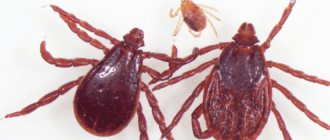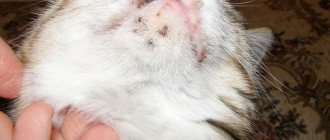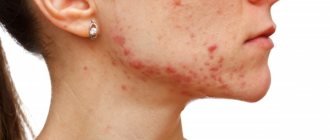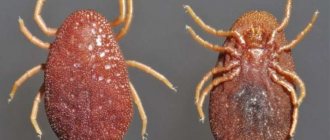Among the diseases that cats suffer from, a significant proportion are those caused by various parasites. One of the most common diseases in this group is demodicosis. The causative agent of demodicosis in cats is the subcutaneous mite. This parasite can cause a lot of anxiety and problems for your mustachioed pet. The Murkoshi team will talk about what it is, how the disease progresses and how to remove this parasite in this article.
1) Pathogens of demodicosis and methods of infection 2) Risk groups 3) Types of demodicosis 4) Symptoms of subcutaneous mites 5) Treatment of a localized form 6) Treatment of a generalized form 7) Prevention of demodicosis
Features of the subcutaneous mite
In cats, demodicosis is often diagnosed. The causative agent of this dermatological disease is the demodex subcutaneous mite. The insect belongs to the arthropod family; there are two types of parasites: gatoi and cati.
Mites reproduce in the glands that produce saliva, sweat and in the roots of hairs. The female lays oocytes, from which larvae appear after 4-6 days. In order to turn into adults capable of reproduction, they need from 7 to 10 days. Microorganisms form colonies, which can be identified by small bumps on the animal's skin. Large accumulations of mites lead to dysfunction of the skin and atrophy of the sebaceous glands.
Demodicosis can be localized or generalized. In the localized form, individual areas are affected: the neck and chin, eyes, ears. Generalized demodicosis spreads throughout the body. The risk group for this type of disease includes representatives of the Burmese and Siamese breeds.
Read also
Ear mites in cats: signs and treatment
The appearance of a parasite such as ear mites in a cat is the beginning of a serious disease that must be eradicated at the first symptoms.
Worms in cats: symptoms, signs and treatment
The first signs of infection may be absent for some time or resemble manifestations of other diseases
Sterilizing a cat: at home or in the clinic?
Sterilization is an intervention as a result of which an animal (a cat in particular) loses its ability to reproduce
Distemper in cats (panleukopenia): symptoms and treatment
Distemper in cats is a serious disease caused by one of the viruses of the Parvoviridae group. The terrible common name means cat
Ringworm in a cat: Treatment and symptoms
Ringworm is a serious infectious disease. When a cat gets sick itself, it transmits the disease to its owners.
Causes of the disease
Subcutaneous mites can live in a cat’s body for many years. The natural defense system restrains its reproduction, the disease does not manifest itself in any way. The tick feeds on dead cells of the epithelial layer. When a cat’s body is weakened, immunity is reduced, microorganisms begin to multiply quickly, and demodicosis appears. The reasons for this phenomenon may be:
- chronic diseases;
- worms;
- non-compliance with care rules;
- poor quality nutrition that does not provide the supply of necessary minerals and vitamins;
- lack of preventive antiparasitic measures.
Stress can also weaken an animal’s natural defense system.
Diagnostics
The process of diagnosing subcutaneous mites in cats is quite complex; it can only be carried out by specialists in laboratory conditions.
Confirmation of the diagnosis is carried out as follows:
- and the contents of the resulting tubercles is performed to make a diagnosis
- Skin particles for analysis are taken by squeezing it on both sides so that the parasites can be squeezed out. Often, several subcutaneous mites can also be found in completely healthy pets. However, if such an amount was recorded in the presence of accompanying symptoms, then a repeat test will be required. Identified parasites are often placed in an artificially created habitat for them in order to be able to observe the process of their reproduction and the development of the created colony.
- The pet's waste products, blood are analyzed, as well as a study of its condition using ultrasound methods. Such diagnostics are necessary to detect possible complications that may be caused by the activity of subcutaneous mites or the accidental entry of secondary microflora into the pet’s body.
Methods of infection with subcutaneous mites
There are several ways of infection with an arthropod parasite:
- transmission of the parasite through direct contact with a carrier;
- indirect contact with the belongings of an infected individual, subcutaneous ticks can get onto a cat from the bedding of an animal that has these diseases, or from a hair brush. A person can carry these microorganisms on clothing if he has had contact with an infected animal.
- intrauterine infection.
Owners of several cats and breeders need to simultaneously treat all pets when the disease is detected.
Diagnosis of demodicosis in pets
Demodicosis has similar symptoms to many other diseases (for example, lichen), so when making an independent diagnosis, the likelihood of making a mistake is very high. The help of a veterinarian in this situation is mandatory.
To detect subcutaneous mites and confirm their assumptions, a specialist will take a scraping for analysis. The biomaterial is collected at the border between healthy and disease-affected areas. It is recommended to do this in the clinic laboratory. This will increase the chances of obtaining a reliable result.
The doctor carries out scarification with a scalpel. At the same time, it necessarily captures deep layers. The biomaterial is transferred to glass, treated with a solution and examined under a microscope.
If a cat has been confirmed to have demodicosis, the owner must clean the house and wash the animal’s rug. It is important to maintain a clean environment throughout the course of therapy.
Pets at risk
No cat breed is immune from demodicosis. Infection with arthropod parasites is not dangerous for a healthy animal. Strong immunity will prevent it from reproducing. However, those at risk include:
- kittens separated from a cat early;
- pets after surgery;
- cats exhausted by prolonged starvation;
- animals with various diseases: rickets, toxoplasmosis, diabetes, leukemia, etc.
The development of the disease can be triggered by stress associated with a change of place of residence or constant visits to the pet groomer.
Complications
Without timely response and comprehensive treatment, animals affected by subcutaneous mites may experience serious complications, which include the following:
- Entry of unwanted microflora into the body, including various types of fungi, which can provoke the parallel development of other diseases.
- The occurrence of abscesses of hair follicles.
- Disruption of the functioning of the sebaceous glands.
- Necrosis of skin tissue and subsequent decay, as well as the breakdown of products of the inflammatory process.
- Intoxication of the animal's body as a whole.
Symptoms of the disease
The rapid growth of subcutaneous mite colonies causes itching in the animal. Active hair loss is observed, and bald patches with an oval outline are formed. In these areas, the skin becomes reddish and ulcers appear. Infectious abnormalities appear as secondary signs. In most cases, subcutaneous mites are localized on the front legs, near the eyes, on the neck, and chin.
The main signs of demodicosis are:
- hair loss;
- swelling, redness of the skin;
- ulcers and pustules;
- decreased appetite;
- weight loss;
- severe itching;
- unpleasant odor;
- unkempt look.
The generalized form, developing, can lead to blood poisoning.
How dangerous is demodicosis for a pet?
If parasitic mites are not dealt with, they will make your cat’s life unbearable. Parasites will constantly provoke pain and itching in the animal, literally eating its skin.
In this case, the disease will further undermine the pet’s immunity. As a result, he will become more vulnerable to many infections and diseases. Sometimes demodicosis in cats causes death.
The medications used to eliminate ticks are extremely toxic to cats. To neutralize their negative impact on the liver, the animal is given hepatoprotectors (for example, Hepatovet or Essentiale).
Treatment of demodicosis
The cat can recover on its own, without therapeutic treatment. But this is only possible with a localized form of the disease, if the pet’s body is strong and has a strong defense system. In any case, if signs of illness are detected, it is necessary to contact a veterinary hospital.
When treating demodicosis in an uncomplicated form, local therapy is used. Can be used:
- Shampoos containing antiseptic components to remove dead epithelial cells and waste products of microorganisms.
- Mitaban solution for treating affected areas. For the treatment of localized demodicosis, a composition with a concentration of 0.25% is used. For a generalized disease without complications, a solution containing 0.5% of the active component is used. If staphylocosis or pyodemocosis has developed against the background of demodicosis, you need a product with a concentration of 1%.
- Advocate drops are used in treatment and prevention. The product is applied with a pipette to places inaccessible to the cat.
- Preparations containing amitraz, pyrethrin for treating affected areas.
- Demodex gel, Saphroderm and sulfuric ointments to eliminate foci of inflammation.
Only a veterinarian should select products, dosages, and regimens of use. Exceeding concentrations can cause harm to the cat’s body.
Is it possible to get infected from a person?
The Demodex mite affects not only animals, but also people. However, these are completely different types of parasite. As has already become clear, infection from an animal is not dangerous. But transmission from person to person is possible.
Routes of infection from humans:
- direct contact;
- cloth;
- bed sheets;
- facial cleansing in the salon.
According to statistics, 90-92% of the population are carriers of the subcutaneous mite. But demodicosis manifests its symptoms only in certain cases: weakened immunity, frequent stress, pregnancy, metabolic disorders.
An exacerbation of the disease is often observed in the autumn season. The reason for this is the experience of hot summer days, when the skin often sweats and becomes oilier. In addition, summer heat, or rather ultraviolet radiation, can significantly weaken the immune system.
Complex treatment of complex forms
If generalized demodicosis or a localized form with complications is diagnosed, then complex therapy is required, including:
- applying Amitraz oil solution;
- oral administration of Doramectin;
- distribution of Ivermec spray on the affected areas;
- parenteral administration of antiparasitic drugs;
- use of antibacterial agents.
At the same time, it is necessary to strengthen the cat’s immunity, for which the biogenic preparations Baksin and Gamavit are used.
Prevention of infection
Due to the fact that there are no vaccinations that could protect a cat from these parasites, it is important to follow some preventive measures to minimize the likelihood of such mites becoming more active and causing serious diseases.
A set of such measures include:
- Prevent your pet from contacting other animals if their health condition can cause even the slightest fear and suspicion.
- Carry out a periodic visual inspection of your pet. At the slightest sign of damage, immediately contact a veterinarian, since in the early stages it is much easier to get rid of the disease.
- During potentially dangerous periods, use various means for preventive treatment of fur or anti-parasitic collars for cats.
- Monitor the living conditions of the pet, compliance with sanitary standards, as well as the quality and balance of nutrition.
- After treating a cat for demodicosis or other similar diseases, it is necessary to disinfect the premises, as well as dispose of or thoroughly treat with special means care items or objects with which the infected pet had contact.
Treatment with folk remedies
In addition to medications prescribed by a doctor, you can use folk remedies to increase the effectiveness of treatment. Treatment of affected areas and wounds can be carried out:
- Ready-made tincture of calendula flowers, purchased at a pharmacy.
- A tincture prepared from the dry herb of tanning mackerel. A spoon of the product is filled with 500 ml of boiling water. After cooling, strain, dilute with 500 ml of cat bathing water.
- Concentrated decoction of chamomile.
Kerosene cannot be used for processing. It causes severe intoxication.
Signs of illness
In its manifestations, damage to the subcutaneous mite is very similar to rosacea or acne. Peeling of the skin and its redness are noted, itching may occur, constant or worsening after using tonics or washing with cold water. Sometimes there is a combination of demodicosis caused by subcutaneous mites and the above-mentioned skin diseases. And this is not surprising, because the occurrence of demodicosis is influenced by negative changes in the skin. Thus, both acne vulgaris and rosacea weaken the skin’s natural defenses. When affected by skin mites, the following parts of the face are most often affected: eyelids, forehead, chin, nasolabial folds and brow ridges. Exacerbations of demodicosis occur in autumn and spring.
Preventive measures
The main prevention of this disease is to maintain a strong immune system in a cat with a complete, balanced diet and proper care. It is also necessary:
- treat the tray, bedding, and bowls with disinfectants every week;
- regularly use sprays and tablets with antiparasitic properties;
- Put your pet on a collar treated with anti-parasite agents.
If a cat has suffered from generalized demodicosis, it must be sterilized.
Prevention of demodicosis in cats
The skin mite is a conditionally dangerous parasite. Usually they are present on the animal’s body, but in minimal quantities. Normally, they cleanse the skin of dead particles. However, when the body's defenses decrease, the number of ticks increases sharply, and then the disease develops.
Thus, prevention should include strengthening the animal’s own defenses. Cat owners must feed it properly and provide adequate living conditions. For animals that are predisposed to the disease, it is useful to administer Immunoparasitan once every six months.
Periodically, the cat needs to be treated with flea medications and given anti-worm medication. During walks, it is important to ensure that the cat does not come into contact with stray animals.
Even if the symptoms of the disease have disappeared, treatment should not be stopped prematurely. To confirm recovery, an additional examination of the scraping is carried out.
How to diagnose demodicosis correctly?
Only a veterinary specialist will be able to correctly assess the damage to your pet’s skin and suggest that you undergo the necessary examination.
Important:
● collect anamnestic data about the sick cat; ● conduct a clinical examination of her; ● examine a scraping of the affected area of skin microscopically for the presence of mites at different stages of its development.
If a Demodex mite is suspected, a skin scraping should be taken before the appearance of ichor (from an intact area of skin). Since the mite penetrates deeply into the skin of the animal, only a scraping test of all layers of skin from different lesions will be informative. A superficial scraping will be false negative.
How to cure a cat for Demodex mites?
Treatment of demodicosis consists of eliminating the tick and eliminating associated symptoms.
Only a veterinarian should select and prescribe medications for a sick pet depending on the course of the disease.
First of all, it is necessary to remove all predisposing factors and not use hormonal drugs. During treatment, control skin scrapings should be examined for the presence of mites every three weeks. Treatment of a sick pet can be stopped only after 3 negative results of control scrapings.
For treatment use:
- Antiparasitic drugs (ivermectins).
- Drugs that increase the biological activity of the body (immunomodulators).
- Anti-inflammatory and antipruritic drugs for external use (ointments, gels, sprays, oils).
- Antibacterial drugs (in case of secondary bacterial infection).
- Bathing using special shampoos (to cleanse the skin).
During the treatment period, the cat's owner must provide it with adequate feeding, follow the rules of maintenance and care (carry out disinfection treatment).
Preventive actions.
I. Carry out timely preventive antiparasitic treatment (from fleas and ticks). II. Avoid contact between a healthy pet and a cat infected with demodicosis. III. Contact a veterinary clinic promptly when the first signs of subcutaneous tick infection appear. IV. It is imperative to treat premises, cages and other places where infected animals are located with acaricidal preparations. V. It is recommended to dispose of items and bedding from a sick animal.
If a cat has suffered a generalized form of demodicosis, it is recommended to sterilize it to avoid further spread of the disease.
It is important to know! Cats that have recovered from the disease do not develop immunity against demodicosis. It is necessary to closely monitor the health of your pet and treat it correctly.
This type of tick is not dangerous to humans.
How do parasites develop?
After fertilization, female subcutaneous mites begin to lay eggs, in some cases these may be larvae. The reasons for the appearance of subcutaneous mites are very varied, however, it is often a lack of proper hygiene.
These subcutaneous microscopic creatures feed on everything they can find in the body of their new owner.
Sarcoptic mange is better known to modern veterinarians than others, since they are most often found on animals. The size of the parasite can reach 0.2-0.5 mm. In most cases, their body has a round shape.











